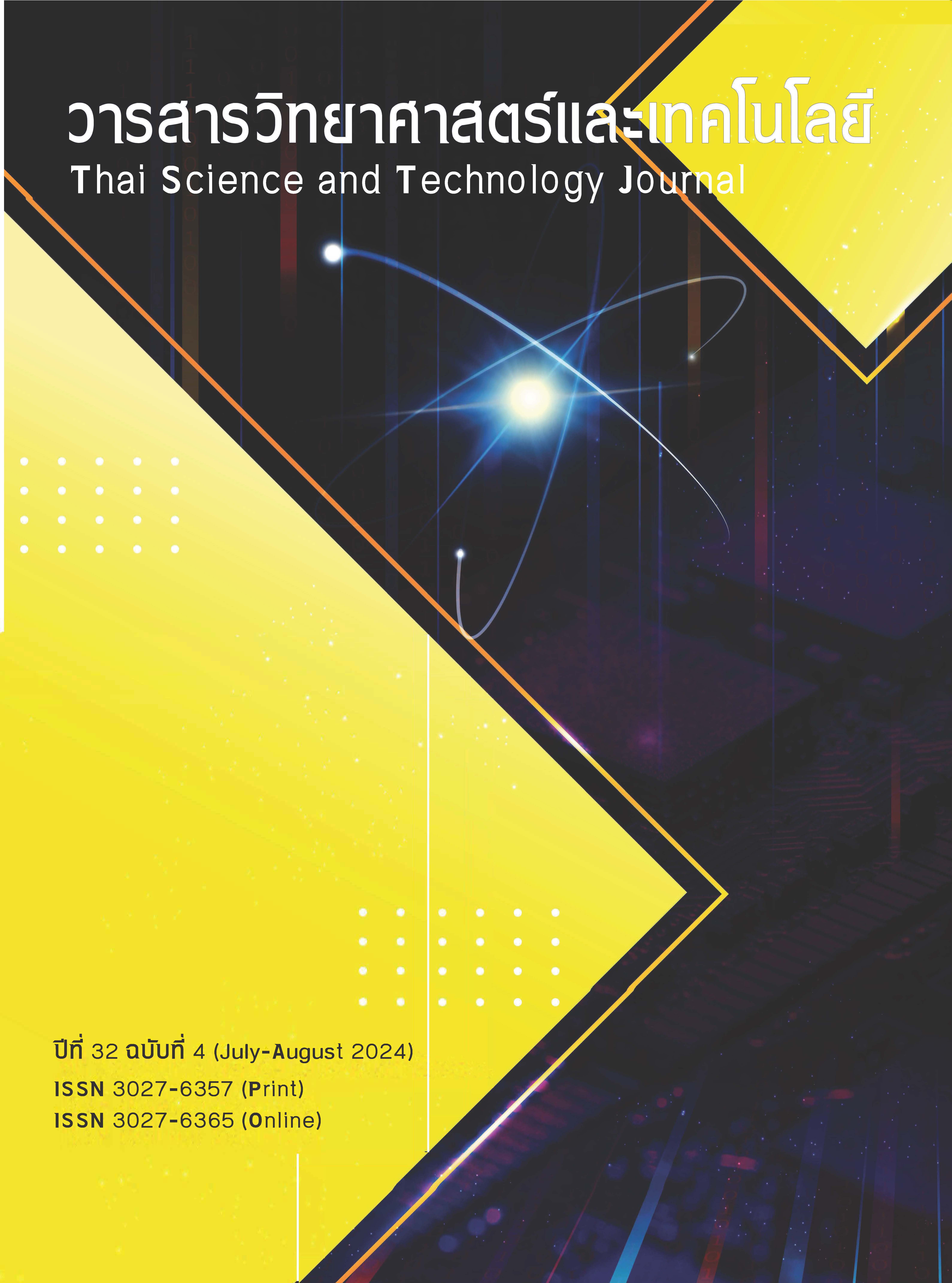ปริมาณน้ำเสียและคุณภาพน้ำเสียจากกิจกรรมการแปรรูปมะพร้าวขาวในจังหวัดสมุทรสงคราม
Main Article Content
บทคัดย่อ
การศึกษาปริมาณน้ำเสียและคุณภาพน้ำเสียจากกิจกรรมการแปรรูปเนื้อมะพร้าวขาวในจังหวัดสมุทรสงคราม ดำเนินการรวบรวมข้อมูลจากสถานประกอบการจำนวน 234 แห่ง ครอบคลุมพื้นที่ 3 อำเภอ 18 ตำบล ในเดือนกันยายน 2561-เดือนธันวาคม 2562 และสุ่มเก็บตัวอย่างน้ำเสียจากสถานประกอบการจำนวน 20 แห่ง ในเดือนเมษายน-พฤษภาคม 2563 ผลการศึกษาสามารถจัดขนาดสถานประกอบการออกเป็น 3 กลุ่ม ได้แก่ ขนาดเล็ก (ร้อยละ 56.5) มีกำลังการผลิตไม่เกินวันละ 1.2 ตัน มีปริมาณน้ำเสีย 1.5 ลูกบาศก์เมตร/วัน, ขนาดกลาง (ร้อยละ 42.6) มีกำลังการผลิต 0.1-3.0 ตัน/วัน มีปริมาณน้ำเสีย 0.3-3.0 ลูกบาศก์เมตร/วัน และขนาดใหญ่ (ร้อยละ 0.9) มีกำลังการผลิตมากกว่าวันละ 5.0 ตัน ปริมาณน้ำเสียมากกว่า 5.0 ลูกบาศก์เมตร/วัน น้ำเสียมีที่มาจากการแช่และล้างเนื้อมะพร้าว โดยมีค่า SS, BOD5, COD และ Oil and Grease อยู่ระหว่าง 72.70- 825.00, 145.50-5,326.00, 287.50-8,742.00 และ 84.00-1,016.00 mg/L ตามลำดับ คุณภาพน้ำเสียหลังไหลผ่านระบบบำบัด มี pH ผ่านเกณฑ์มาตรฐาน ค่า BOD5, COD และ Oil and Grease ของน้ำเสียหลังไหลผ่านระบบบำบัดมีแนวโน้มลดลงเฉลี่ยร้อยละ 93.6±4.1, 93.8±7.6 และ 94.5±7.5 ตามลำดับ แต่ยังคงมีความเข้มข้นของ SS, BOD5, COD และ Oil and Grease สูงเกินกว่าเกณฑ์มาตรฐานการระบายน้ำทิ้งตามประกาศกระทรวงอุตสาหกรรม พ.ศ. 2560 และประกาศกระทรวงทรัพยากรธรรมชาติและสิ่งแวดล้อม พ.ศ. 2564
Article Details
เอกสารอ้างอิง
eenjaitrong, C. and Haocharoen, K., 2020,Cultural Landscape of TraditionalCommunity in Samut SongkhramProvince, Journal of the Faculty of Architecture King Mongkut’s Institute of Technology Ladkrabang, 31:17-33.
Meksumpun, J., 2022, Mae Klong and the conservative development, KasetsartUniversity, Bangkok (Thailand). Faculty of Fisheries, Department of Fishery Biology.
Aschariyaphotha, W., Rittimontri, K., Chuankuntod, K. and Kasetkitchakan, T., 2022, The Effects of Coconut Water on the Growth of Coriander (Coriandrum sativumL.) in Hydroponics, Journal of Research and Innovation in Science and Technology, 3(3), 57-65.
Selakorn, O., Sutaphan, S., Phasinam, K., and Kassanuk, T., 2020, The OptimalConcentration of Coconut Water on Multiple Shoot Induction of Musa (AAA group) ‘Kluai Nak’ In Vitro, YRU Journal of Science and Technology, Vol.5, no.1, pp. 28-33.
Papun, B. and Chomsri N., 2021, Growth Characteristics of Acetic Bacteria in Coconut and Pineapple Juices, Journal of Innovative Technology Research, 5(1), 2-11.
Yamane, T., 1973, Statistics: An Intro-ductory Analysis (3rd Edition), Harper and Row, New York.
R Development Core Team., 2020, R: A Language and Environment for StatisticalComputing, Vienna, Austria: The R Foundation for Statistical Computing,ISBN: 3-900051-07-0.
APHA, AWWA, WEF., 2012, StandardMethods for Examination of Water and Wastewater, 22nd Ed., American PublicHealth Association, Washington, DC, 1360 p.
Chanakya, H. N., Khuntia, H. K., Mukherjee,N., Aniruddha, R., Murakami, J. R., and Thimmaraju, P., 2015, The physico-chemical characteristics and anaerobicdegradability of desiccated coconutindustry wastewater, Environmentalmonitoring and assessment, 187(12), 772.
Ministry of Natural Resources and Environment, 2022, February 26, Notification of the Ministry of NaturalResources and Environment regardingstandards for controlling wastewaterdrainage from small establishments that produce certain types of goods or provide services, B.E. 2021. Royal Thai Government Gazette, 139 (48), 29-32. (in Thai)
Minister of Industry, 2017, June 7, Notification of Ministry of Industryregarding Industrial Effluent StandardsB.E. 2560. Royal Thai GovernmentGazette, 134 (153), 11-15. (in Thai)Science32-N4.indd 41Science32-N4.indd 418/8/2567 BE 15:028/8/2567 BE 15:02
Abdalla, K.Z. & Hammam, G., 2014,Correlation between Biochemical OxygenDemand and Chemical Oxygen Demand for Various Wastewater Treatment Plantsin Egypt to Obtain the Biodegradability Indices, International Journal of Sciences:Basic and Applied Research, 13 (1), 42.
Chukeaw, T. and Thawornchaisit, U., 2018, Biodegradability Enhancementand Decolorization of Molasses-basedWastewater from Distilleries by Electrocoagulation, Journal of ScienceLadkrabang, 27(2), 65-79. (in Thai)
Płuciennik-Koropczuk, E. and Myszograj, S., 2019, New Approach in COD Fractio- nation Methods, Water, 11 (7), 1484 p.
Lertsriwong, S., Comwien, J., Chulalaksananukul, W., and Glinwong, C., 2017, Isolation and identification of anaerobic bacteria from coconutwastewater factory for ethanol, butanol and 2, 3 butanediol production.International Biodeterioration & Biodegradation, 119, 461-466.
Niyomrath, R., Korbouakaew, K. and Sirithongthaworn, S., 2021, ProcessImprovement of White Coconut MeatProduction in Samut Songkhram Province,The Journal of Industrial Technology:Suan Sunandha Rajabhat University, 9 (2), 59-66. (in Thai)
Srivichai, P. and Rodsrida, C., 2021,Wastewater Treatment with ActivatedSludge Process, Advanced ScienceJournal, 21 (2), 16-29. (in Thai)Science32-N4.indd 42Science32-N4.indd 428/8/2567 BE 15:028/8/2567 BE 15:02


